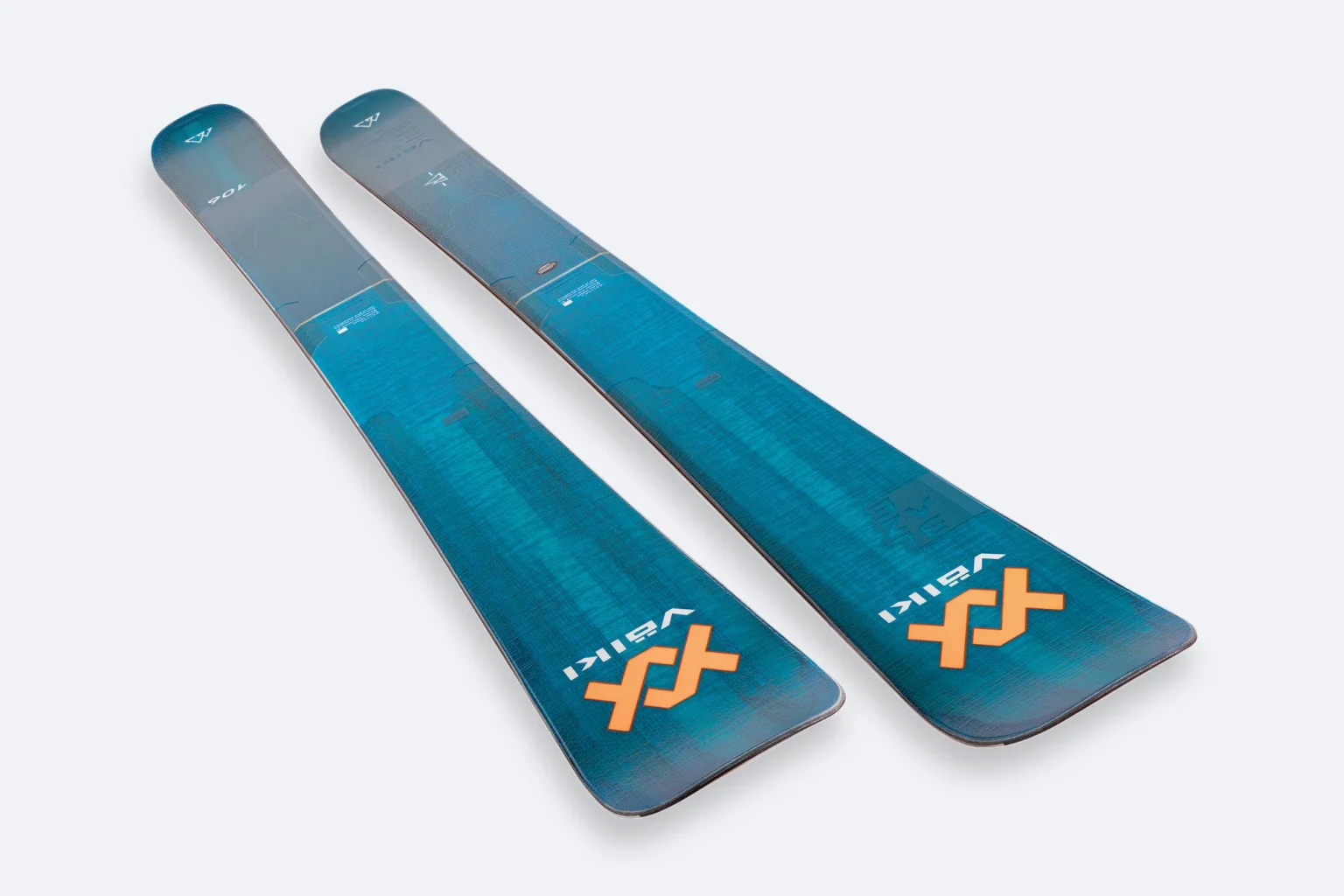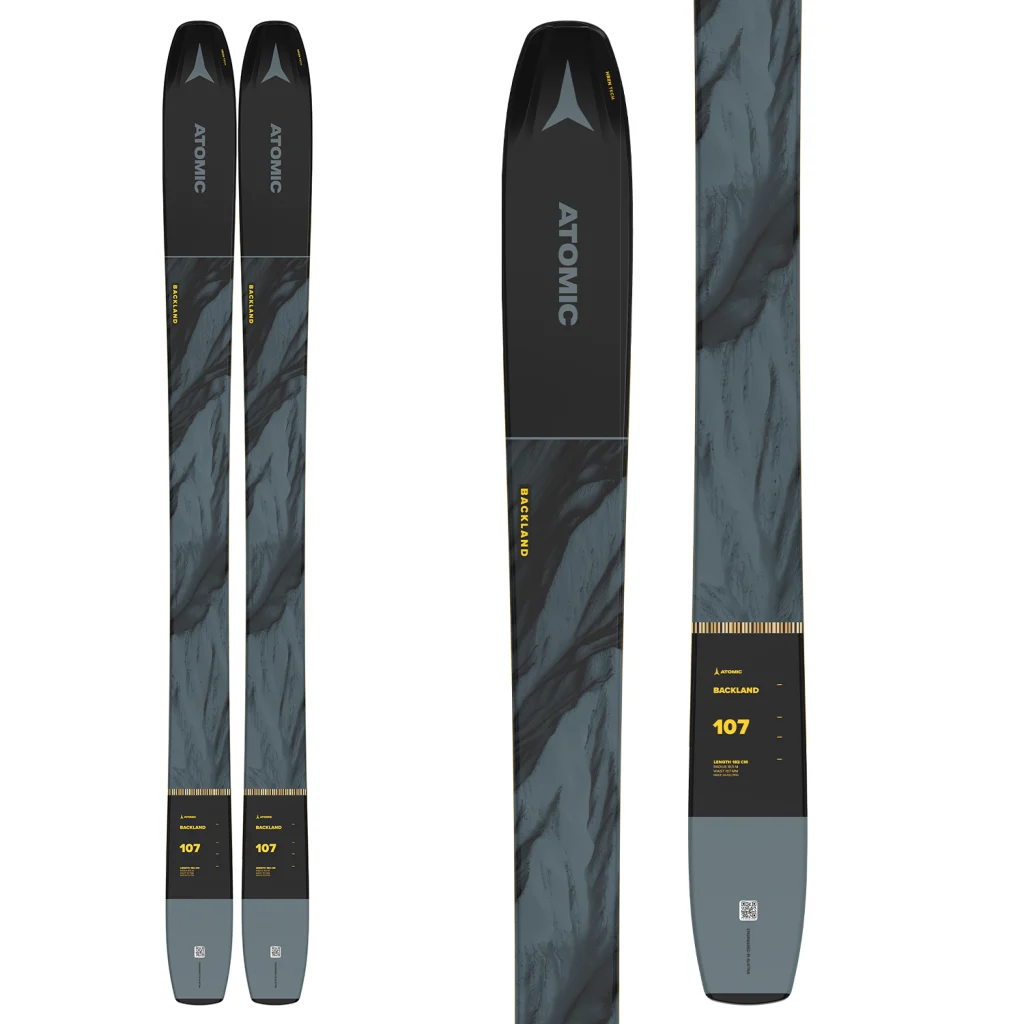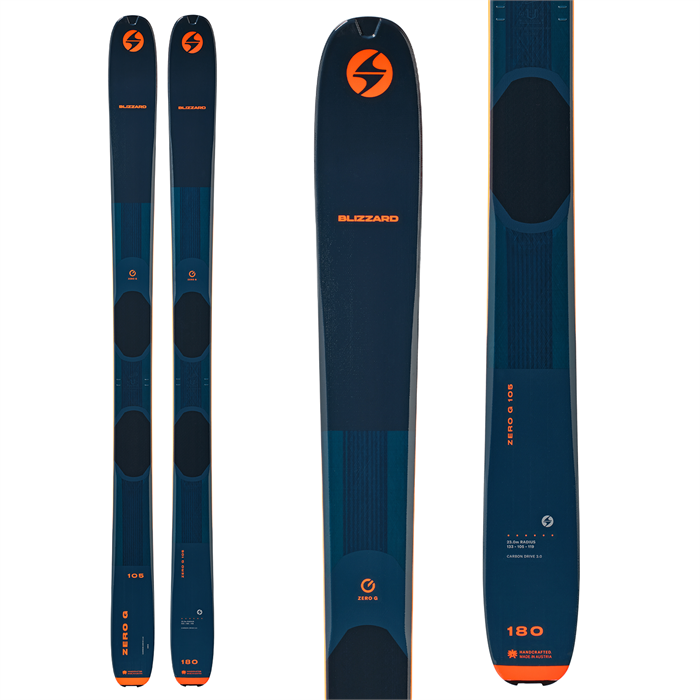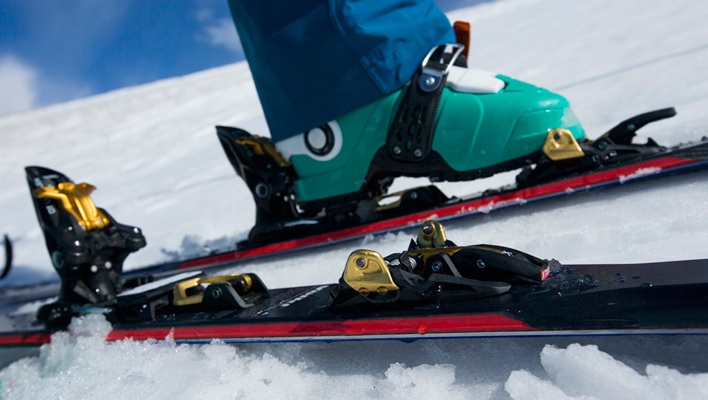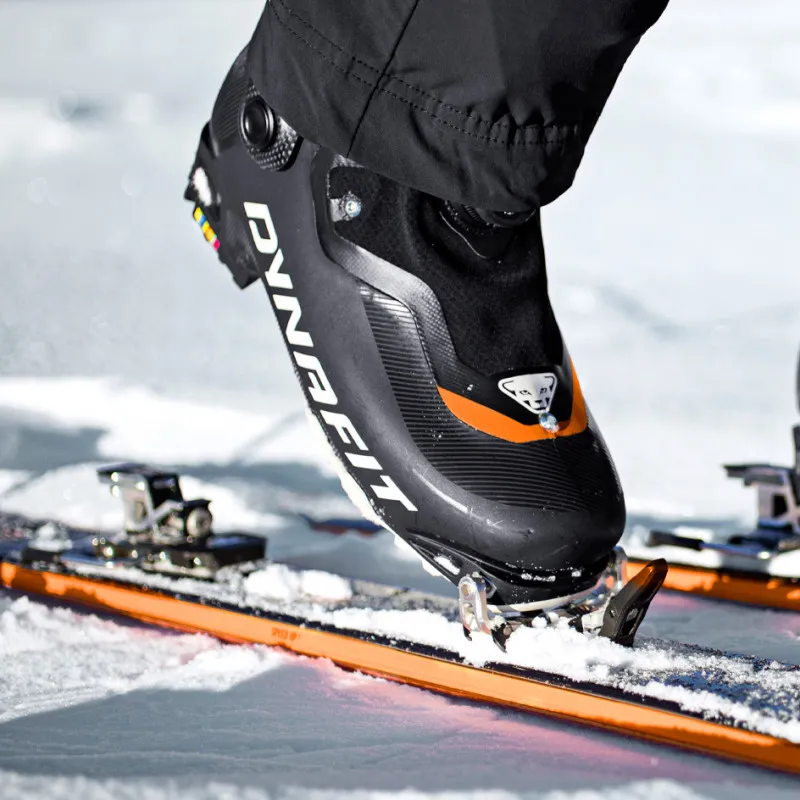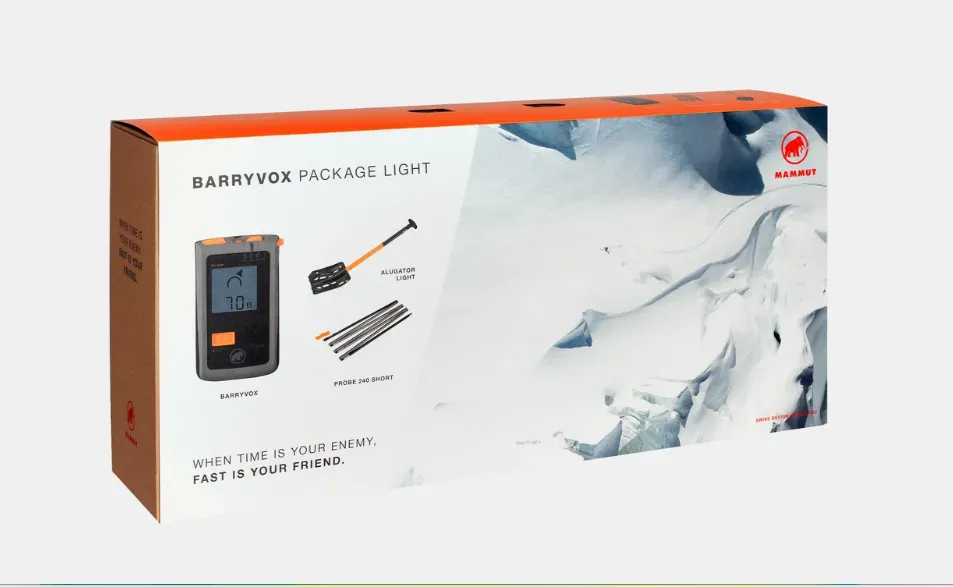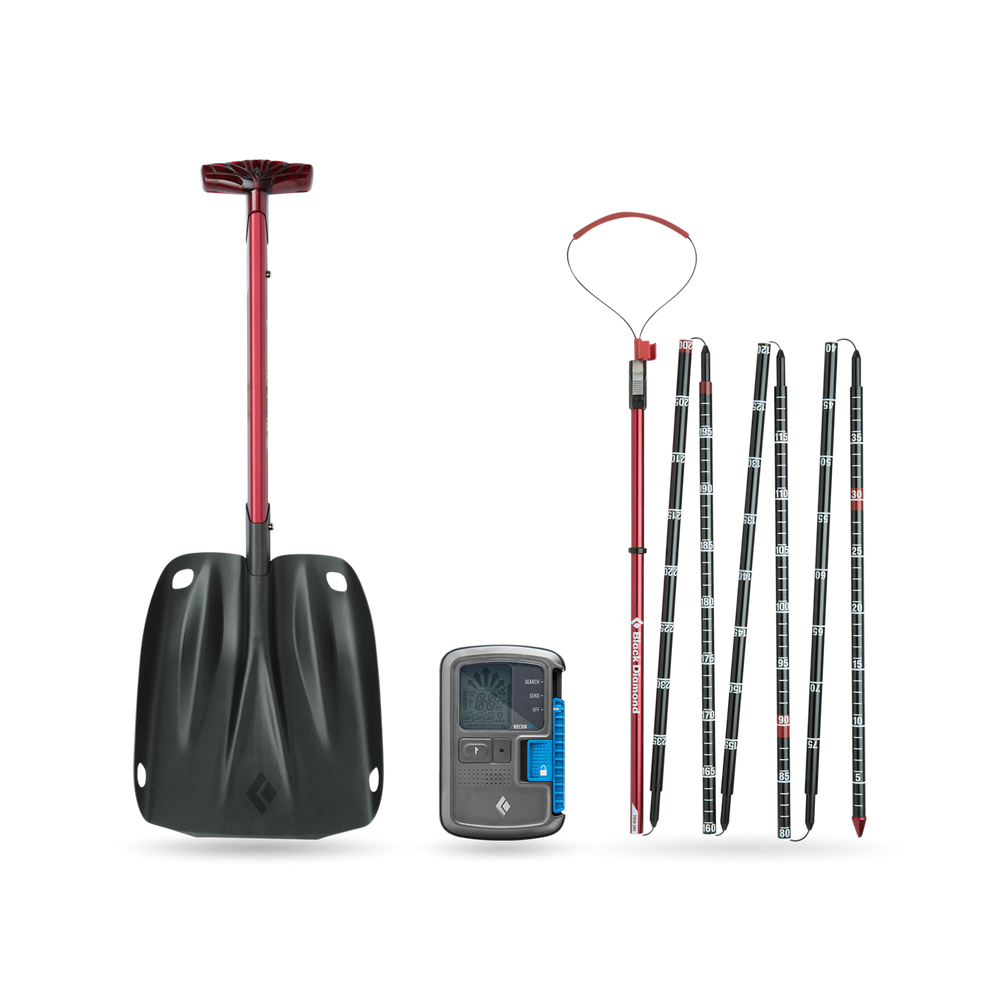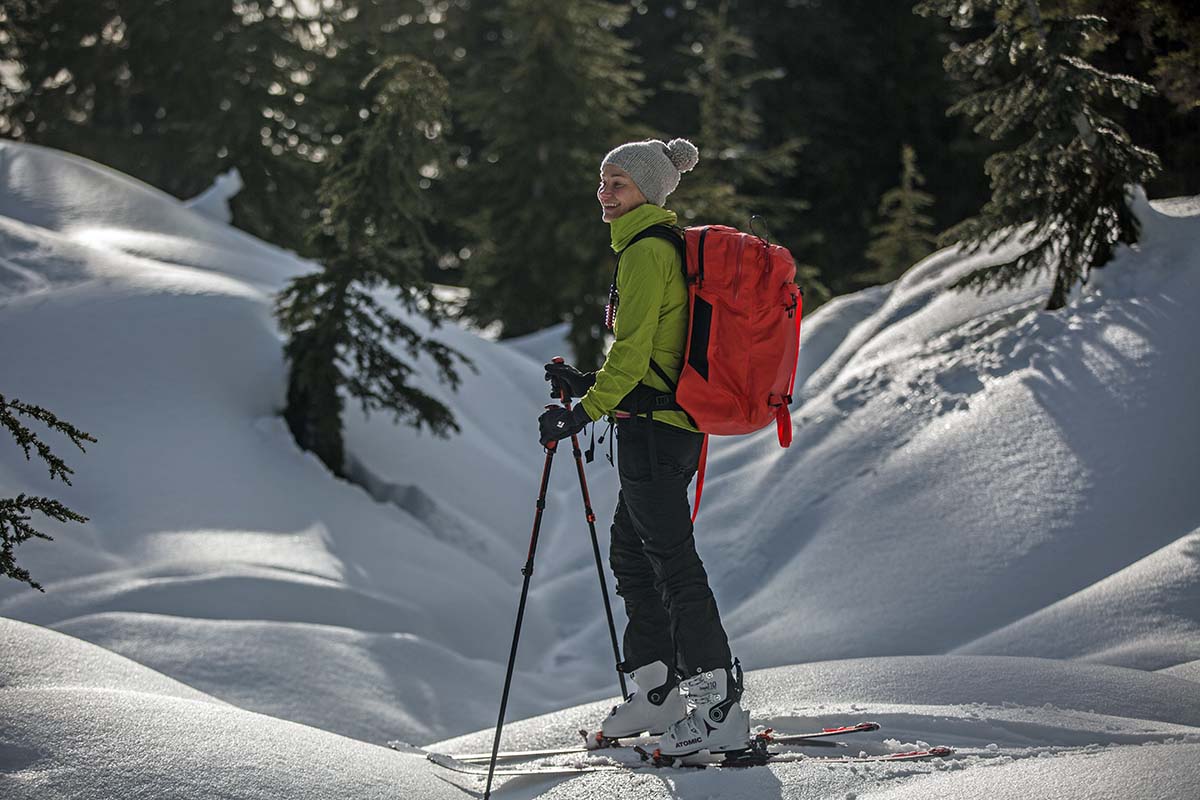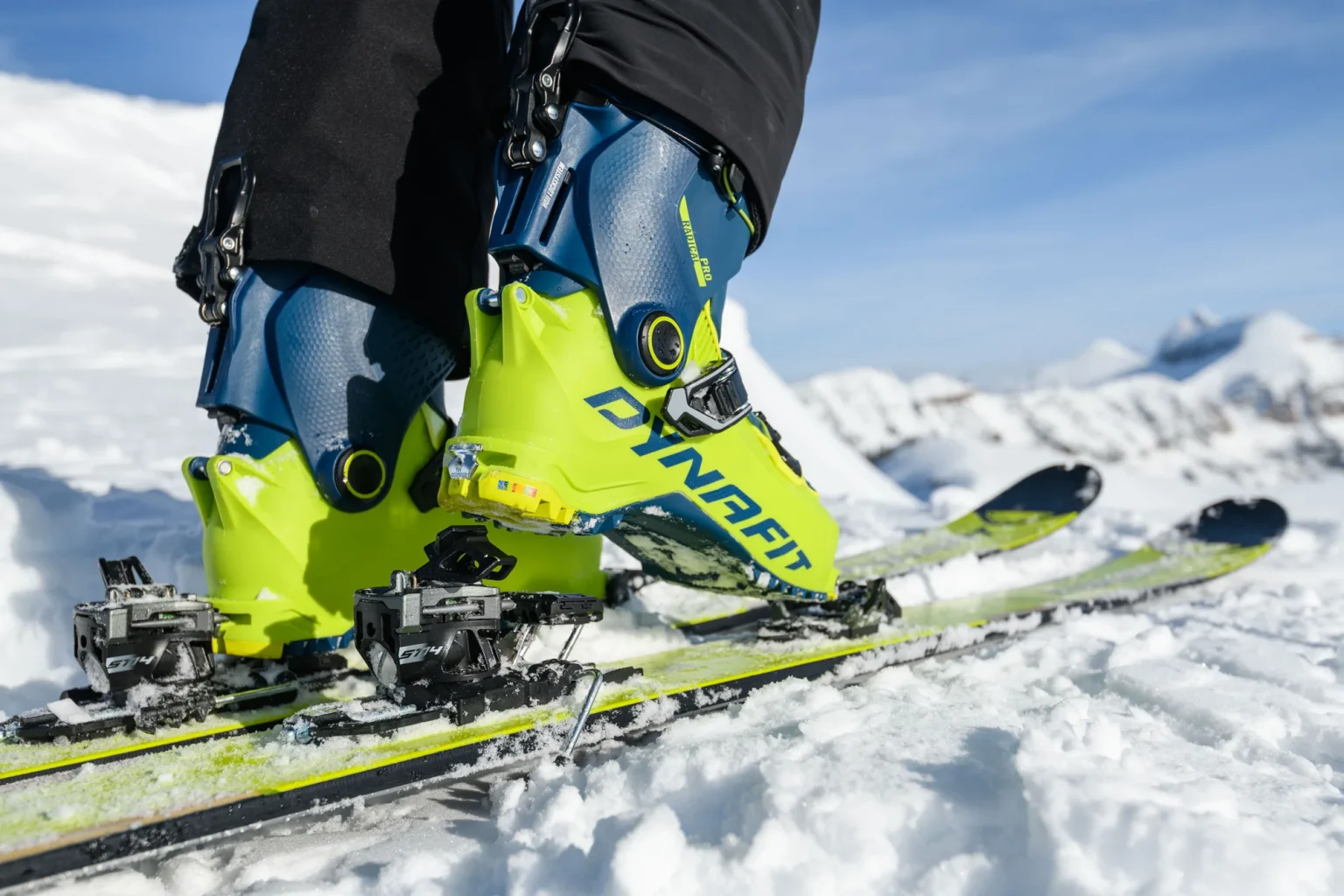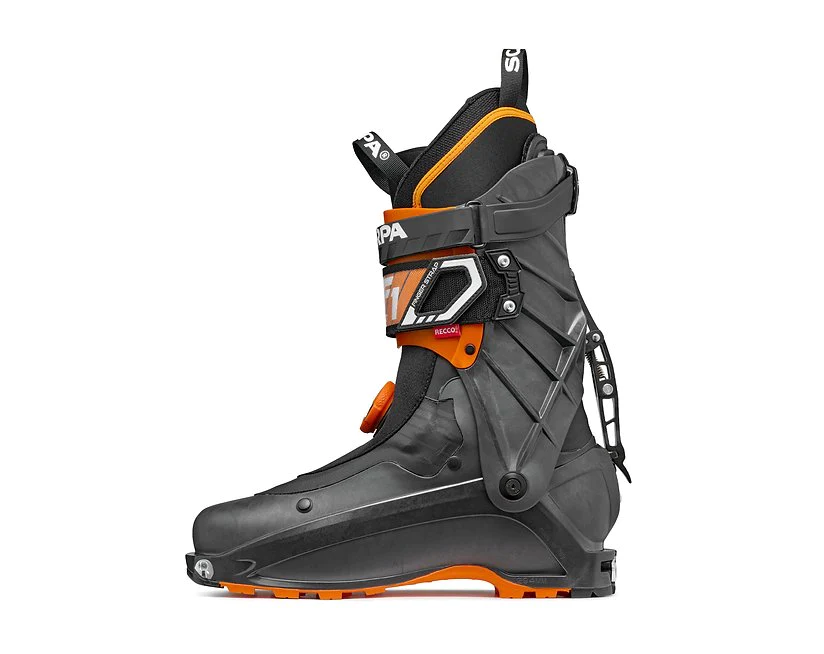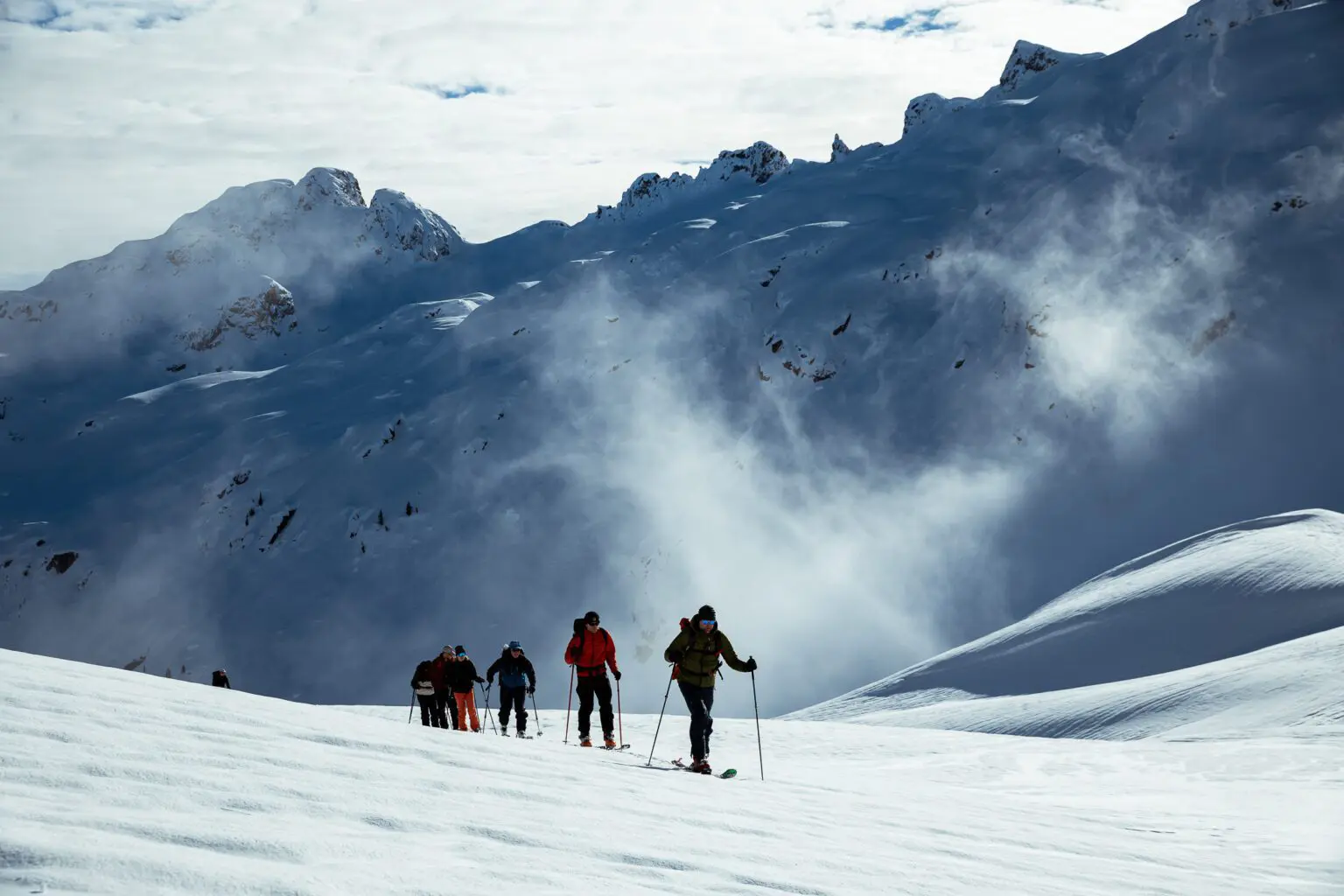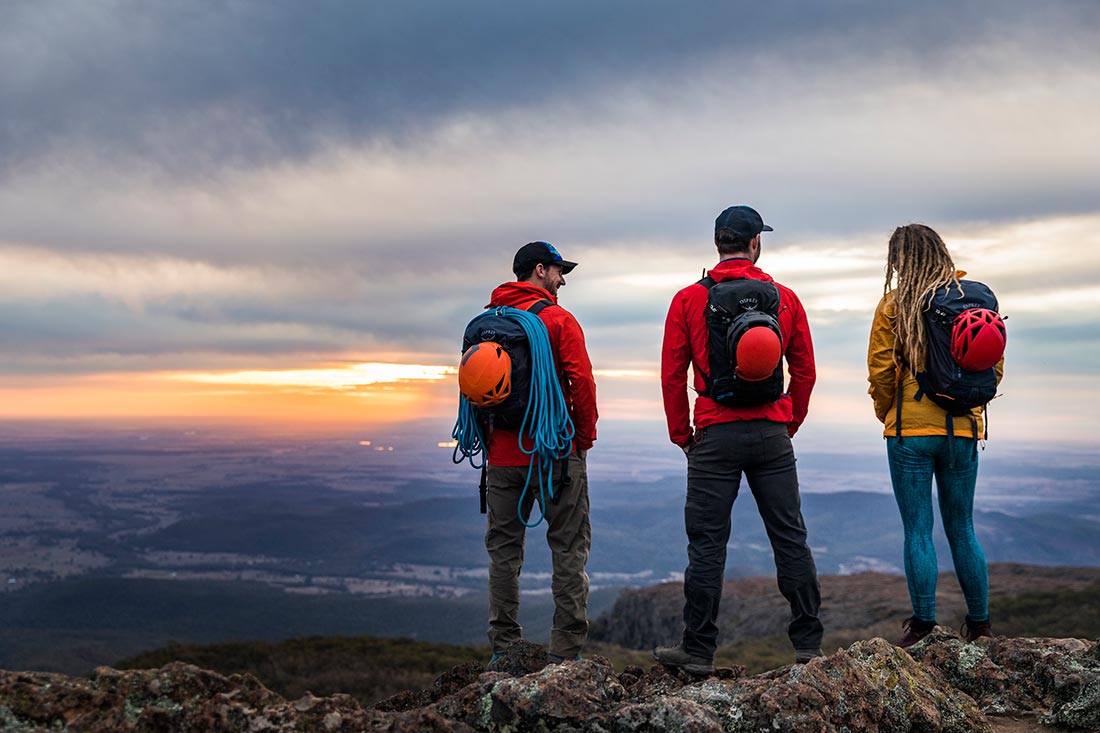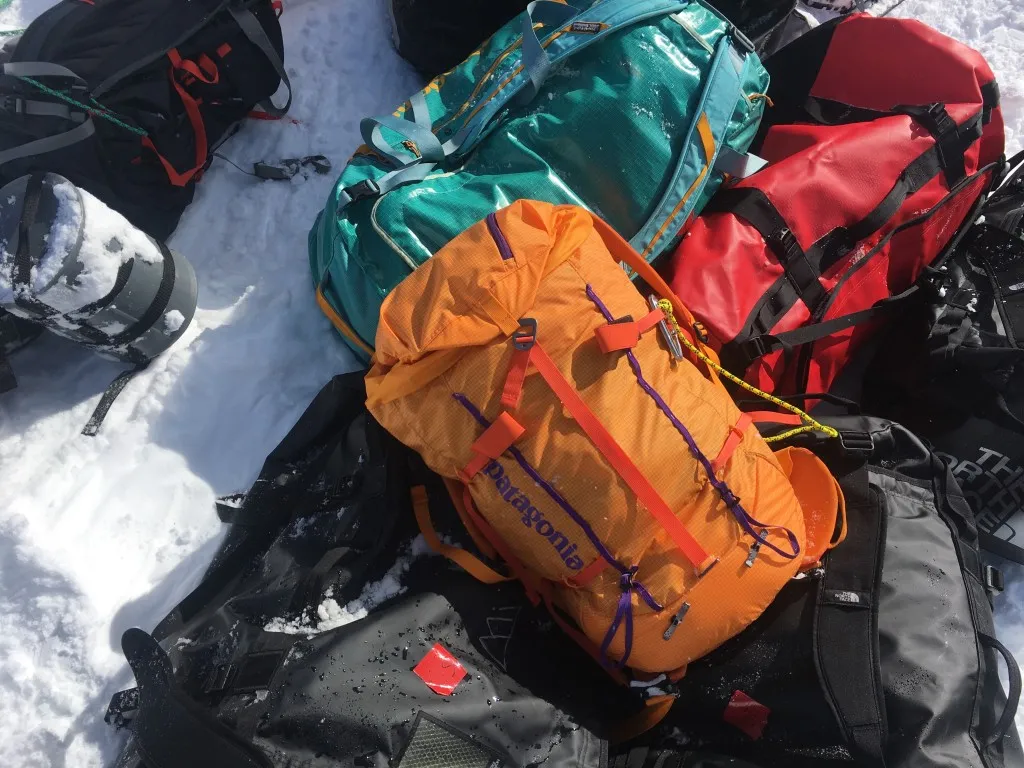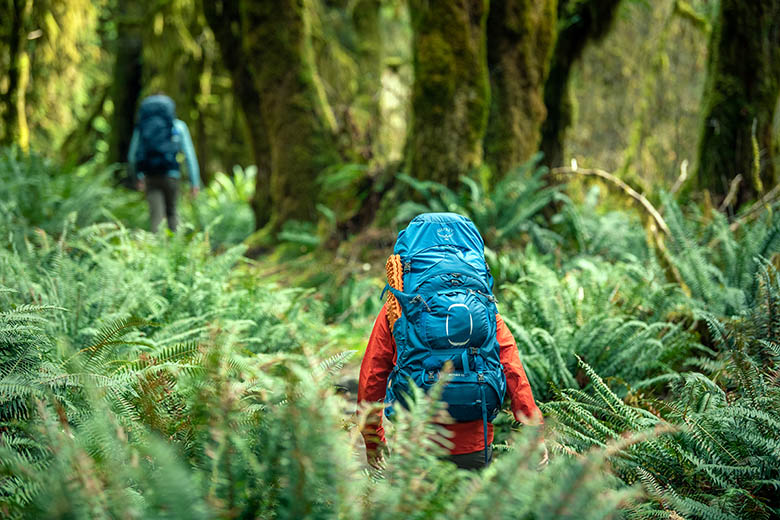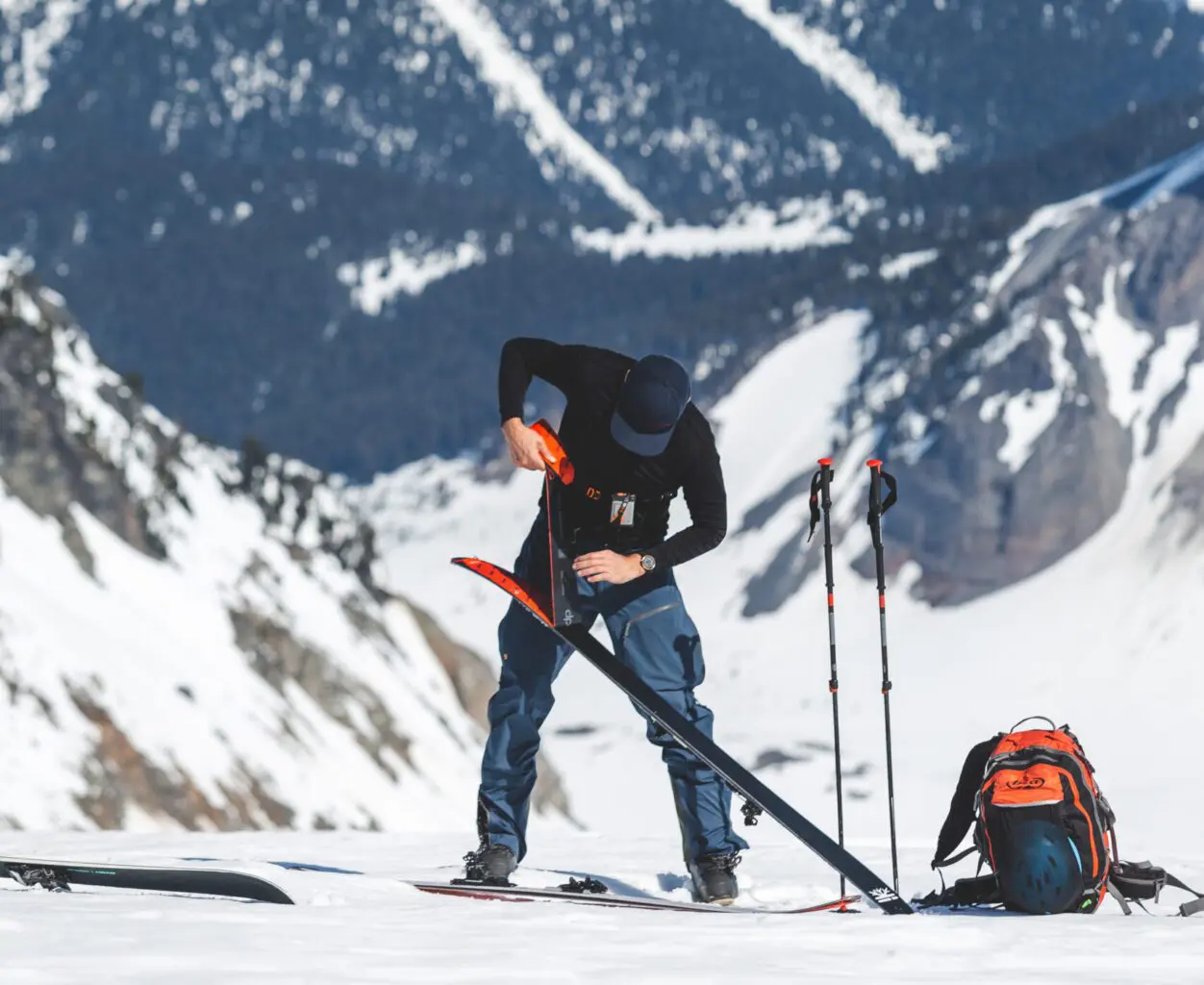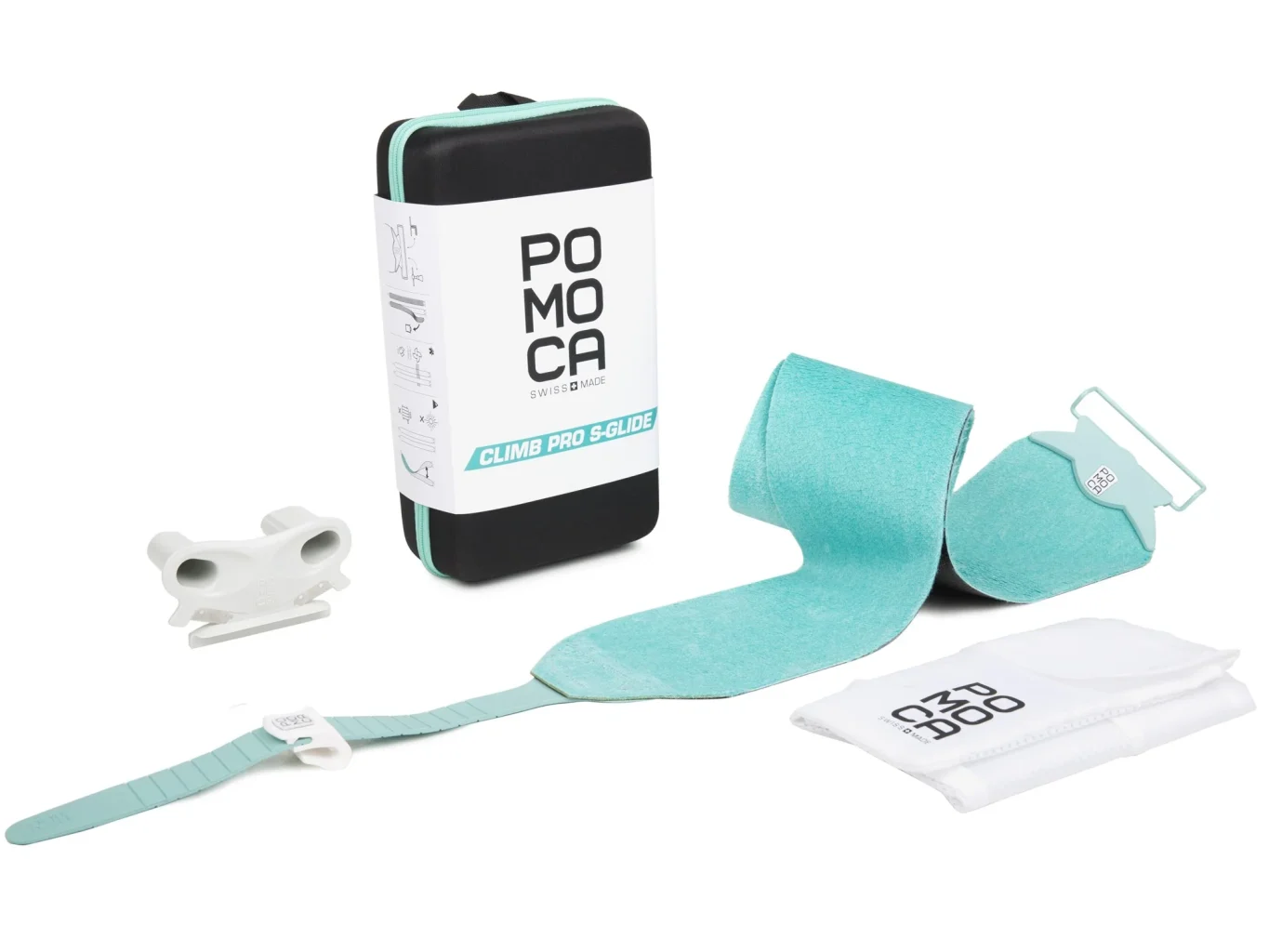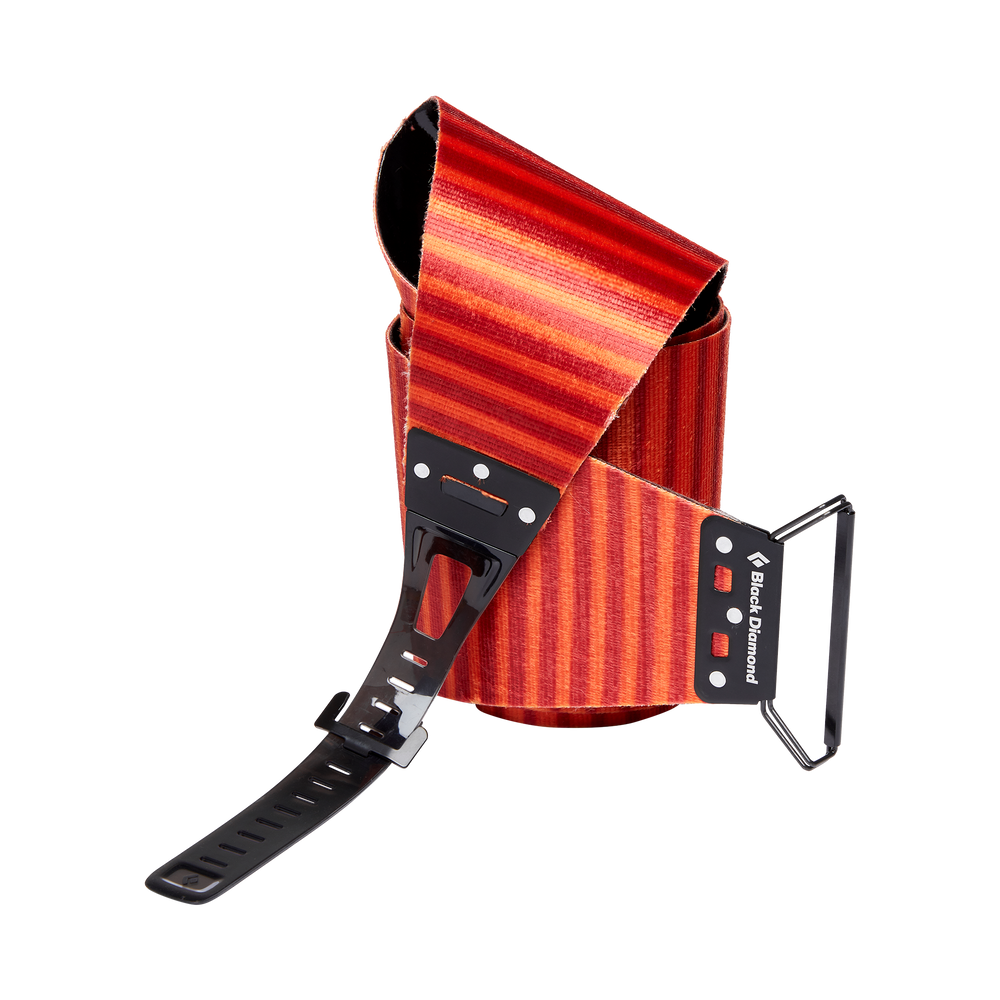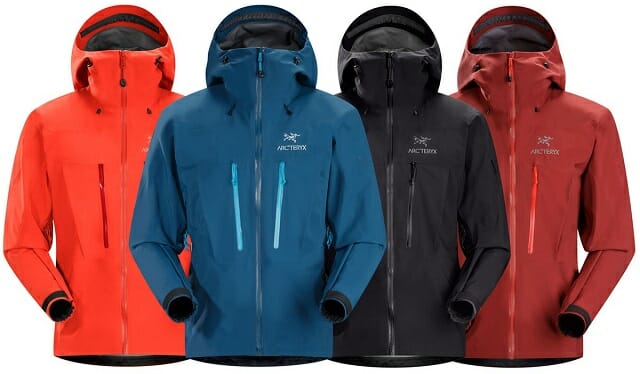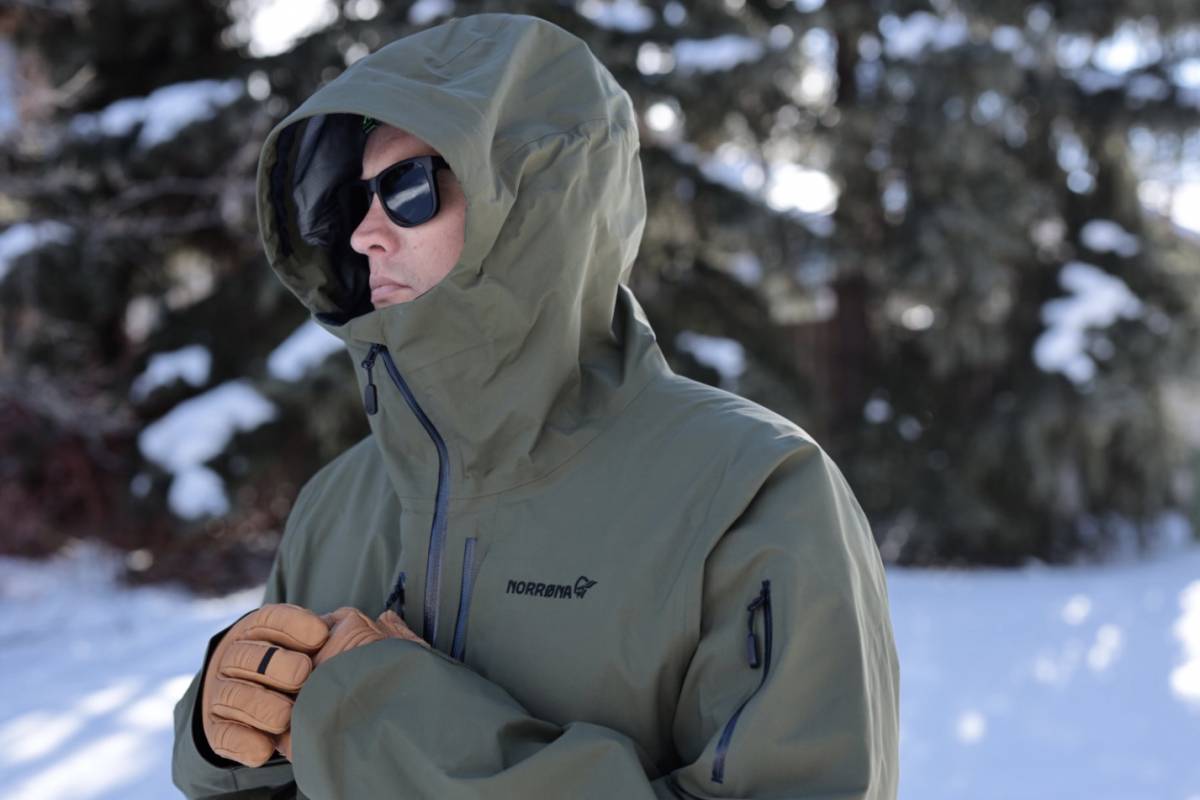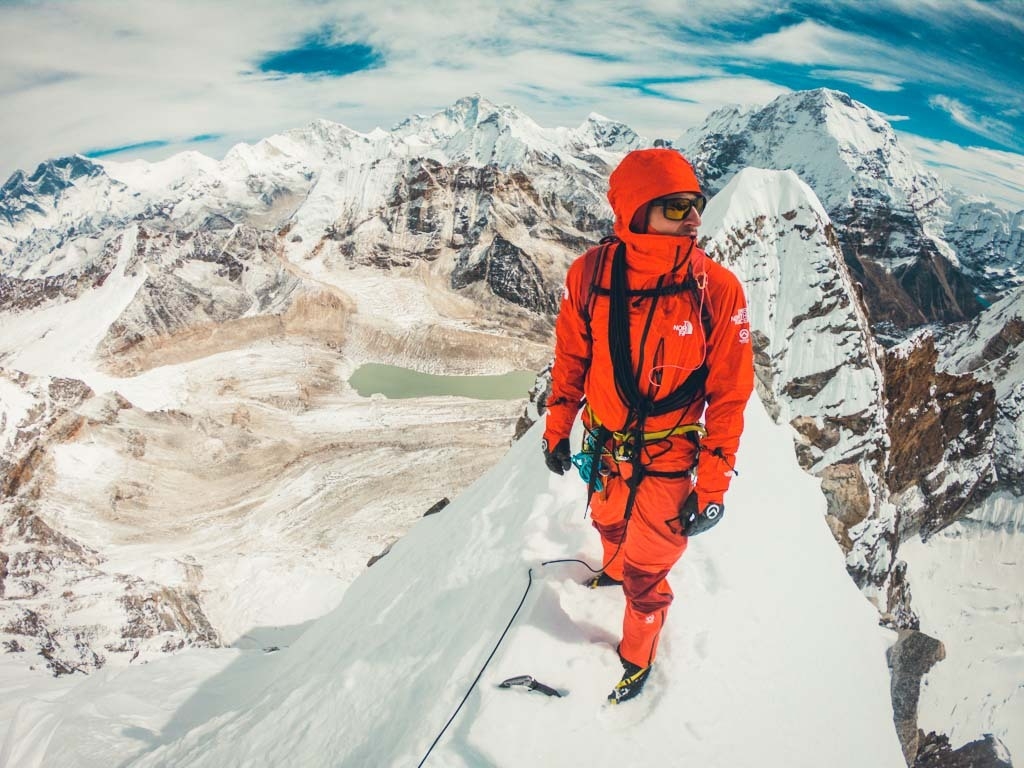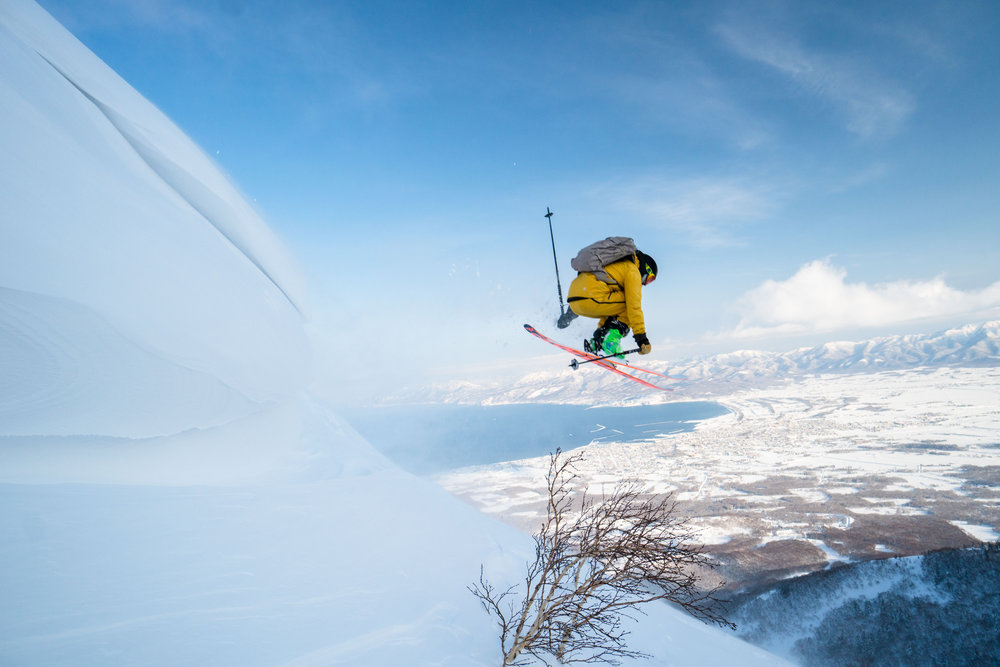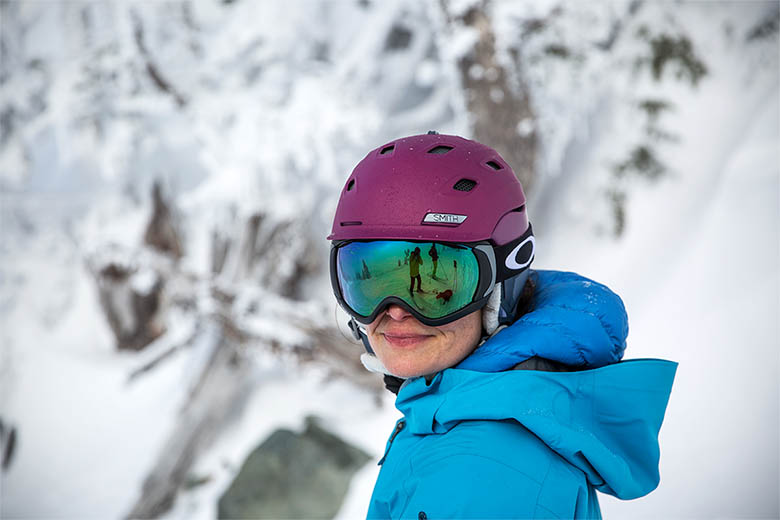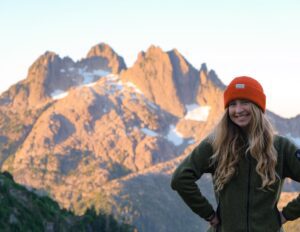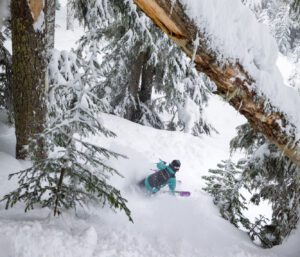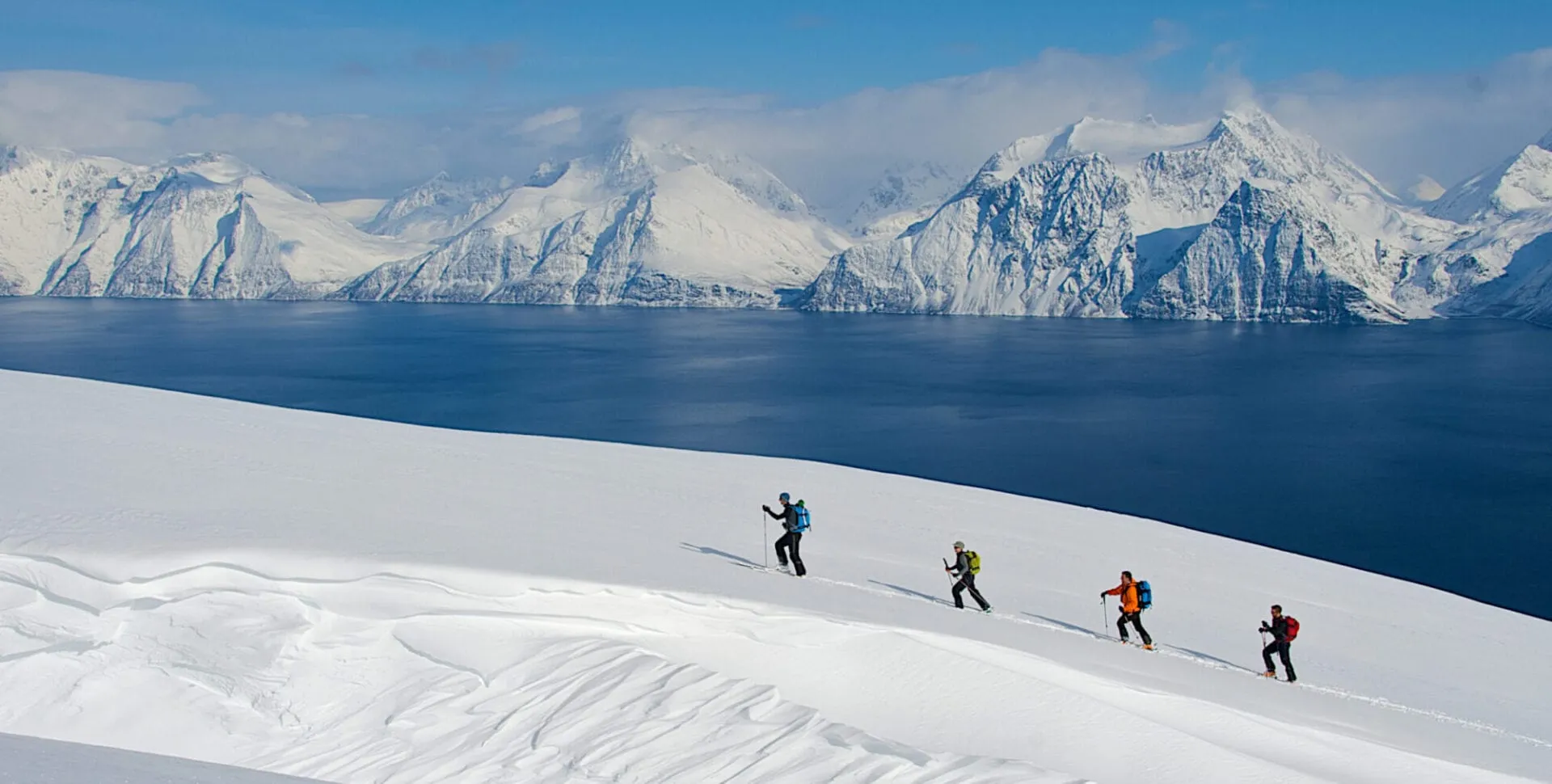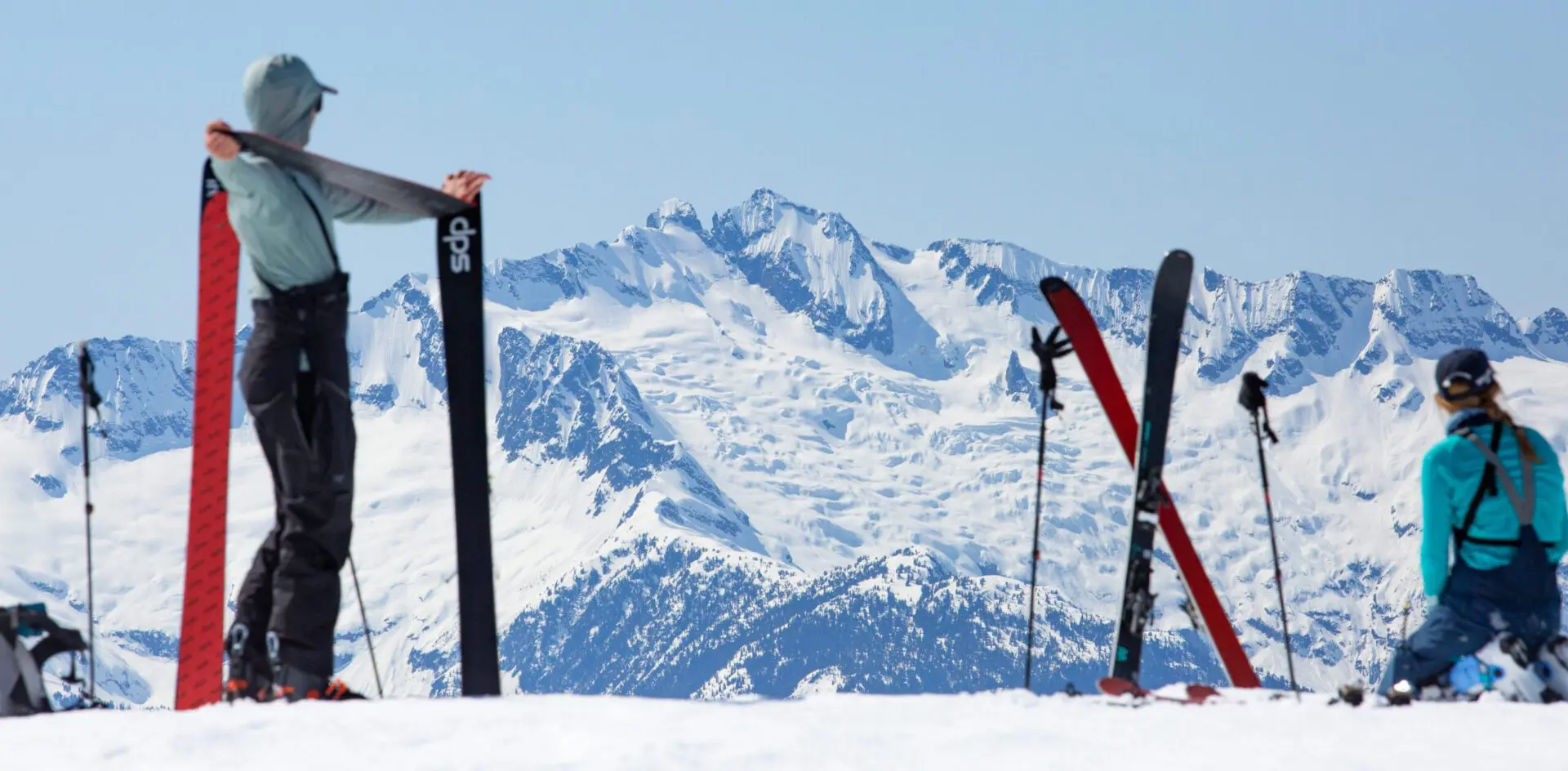
What is Ski Touring?
Ski touring is when you ski in the backcountry using specific equipment to glide uphill on skis. Once you’ve reached your summit or chosen destination, you can transition your gear to function as regular downhill skis and enjoy fresh lines on your descent. This strategy unlocks remote terrain you cannot find in resort. Skiers should be equipped with avalanche safety training and should go with a guide until completely comfortable in the backcountry. Your ski touring equipment will be different from your typical resort skiing setup. Though some downhill skis can double as touring skis, your bindings and boots will need to be touring specific. You will also need skins for the underneath of your skis when travelling uphill, a backpack with avalanche safety equipment and it is recommended to use adjustable poles with powder baskets.
Choosing The Right Ski Touring Equipment
Picking your ski touring equipment can seem overwhelming, but it is important to take the time to figure out what equipment is best suited for you. Your equipment will be based on your style of skiing, desired setup and budget. Choosing the right equipment will make all the difference – the last thing you want is to be four hours into an uphill tour with blisters from your boots or skis that are far too heavy. The correct avalanche safety equipment is even more important. When in avalanche terrain, you always need to be prepared for anything.
Touring Specific or Resort Hybrid?
When researching ski touring equipment, it is important to first decide if you want a strictly touring setup or a resort-touring hybrid. Both options come with their pros and cons.
If you’re on a budget or just starting out, the hybrid option is great as you can have one pair of skis, boots and bindings whether you’re in the backcountry or in resort. The downside is that your hybrid setup will be heavier and your boots will be stiffer, though your bindings will be more durable. This setup is great if you’re doing a few touring days a year, but might drag you down if you want to focus more on uphill touring and multi-day trips.
A touring-specific setup will have more functions and will likely be more comfortable than a hybrid option. Your skis will be lighter – ideal for uphill travel and powder, whilst your boots will have more flex. There are a couple of options for bindings; either a shift setup which is more durable for your descents, or a simple pin binding weighing next to nothing. As for the cons, a touring-specific setup is usually more expensive than a hybrid. And if you’re looking for lots of resort days, you will likely need separate downhill skis, as touring-specific equipment can be less durable.
The Best Ski Touring Gear for 2025
Touring Skis
Touring skis will need to be light enough to hike up a mountain but also stable enough to ski in varied conditions. Some skiers like a shorter ski to ensure their setup is as lightweight as possible. There are endless models and styles to sort through, so we’ve listed options ranging from beginner backcountry skis to models suitable for seasoned ski tourers looking for an upgrade. Here is our list of the best touring skis:
Volkl Blaze 104 – from £650 / US$840
3600g (179cm)
The Volkl Blaze is our top choice for a touring resort hybrid. If you’re looking to get into ski touring by doing a few trips a season, these are the skis for you. They are technically an all-mountain ski but are extremely lightweight for the category, making them the perfect touring-resort hybrid. With the correct bindings, the Volkl Blaze can double as a resort ski, meaning you can get by with just having one set up for the backcountry and resort. The skis are light enough to tour up a mountain but also sturdy enough that you can ski any icy resort conditions, especially with the new shock-absorbing suspension tip. The Volkl Blaze is the ideal ski for those interested in touring but not quite ready to purchase a specific touring setup.
Atomic Backland 109 – from £650 / US$835
3080g (184cm)
The Atomic Backland 109 is one of the most popular models of touring skis. They are a great choice if you’re new to the backcountry. The skis are lightweight for the uphill trek and responsive enough on the downhill to ski in various conditions. HRZN 3D tips offer great performance in powder with a widened surface area. Having ultralight skis can sometimes take away from control in icy or variable conditions, but the Backlands offer enough stiffness to trust your edges. Overall, the Atomic Backland 109 is a great intro to touring ski with lightweight versatility and a variety of lengths.
Blizzard Zero G 105 – from £740 / US$950
3100g (180cm)
The Blizzard Zero G’s are often said to be one of the top-performing ultra-light skis. Though they are one of the lightest on this list, the Zero G’s still manage to ski quite aggressively. In varied downhill terrain, the Zero G’s perform just as well as some of its heavier competitors. Though there are still lighter skis on the market, the Blizzard Zero G’s are a great option if you’re looking to transition to a very lightweight ski but don’t want the fragility that often comes along with it. Perfect for a backcountry skier who wants to focus on the downhill without having to tour up with a pair of heavy all-mountain skis.
Extrem Fusion 95 Carbon Ultra – from £825 / US$1065
2740g (179cm)
The Extreme Fusion 95 is a true ultra-lightweight ski. Designed for variable conditions, this ski is ideal for the uphill-focused skier looking to embark on long tours, without compromising the downhill experience. The ski has a poplar-paulownia wood core with carbon stringers, a lightweight Tubecomb tip insert, and an ABS tail protector. This model has the same proven shape as the Fusion 95 with a tapered side cut and progressive rocker for smooth descents. Overall, the Extrem Fusion 95 Carbon Ultra is for the skier who wants to venture further into the backcountry and does not want to be held back by weight.
Ski Touring Bindings
Ski touring bindings are the most important function for your touring setup. Touring-specific bindings grant skis the ability to unlatch their heel, making the uphill ‘glide’ possible. There are a variety of binding options from lightweight pin binders to resort-capable frame bindings. We’ve listed the styles available and our favourite models. Here is our list of the best ski touring bindings:
Marker F12 Alpine Touring Binding – from £330 / US$425
2360g per pair
The Marker F12 Alpine Touring Binding is what is called a frame binding. This is a different setup to the other bindings on our list. When using a frame binding on the uphill ascent, backcountry skiers will have their boots locked into the binding, while the binding itself is unlatched from the ski at the heel to allow gliding movement. The pros of the Marker F12 are that this binding can double up as your everyday resort setup. It can also fit a regular downhill boot. This binding is a good option for beginner backcountry skiers. It is durable, and skis like an alpine binding. When in walk mode, the frame lift is very stable and easy to get the hang of. As for cons, the binding is a lot heavier than the competing pin bindings. When first getting into ski touring this shouldn’t be too much of a problem but over time a skier will most likely need to upgrade to something more lightweight.
Overall, the Marker F12 Alpine Touring Binding is a great option for new ski tourers. Price-wise it is on the cheaper side but an upgrade might be needed after a few seasons of ski touring.
Salomon S/Lab Shift – £460 / US$590
1700g per pair
The Salomon S/Lab Shift has quickly become one of the most popular touring bindings. It appeals to a range of backcountry skiers as it transitions from an uphill pin binding to a full alpine downhill toe piece. A pin binding is when there are two steel pins on the front binding piece that snap into place with the toe of a compatible boot. This allows a more natural uphill glide and less weight as the binding requires no frame. As for downhill, the Shift can transition into an alpine toe piece offering maximum control and durability on the descent. The Salomon Shift is therefore the ideal resort-touring hybrid. It is the perfect binding for those wanting a one-size-fits-all ski setup allowing you to split your time between resort and backcountry. You can ski aggressively on the downhill as your power transmission from boot to ski is similar to that of a typical alpine binding.
Marker Kingpin – from £399 / US$510
1390g per pair
The Marker Kingpin offers a pin toe piece and a traditional alpine heel. The uphill function is the same as most pin bindings but on the downhill, you are clipped into a heel piece similar to that of regular alpine bindings. This allows for more aggressive skiing without sacrificing weight. It is ideal for backcountry skiers who like to focus on challenging downhill terrain but appreciate lightweight equipment.
Dynafit Rotation – from £415 / US$535
1198g per pair
The Dynafit Rotation is a true ultra-lightweight binding. It is top-of-the-line tech offering a rotating toe piece and heel piece. Transition from walk to ski mode is simple and user friendly. When it comes to the downhill, pin bindings in general take some time to get used to as your power transmission from boot to ski has less points of contact. That being said, the Dynafit Rotation’s downhill performance holds up to some heavier pin bindings. The Rotation is great for skiers who want the lightest setup but don’t want to hinder their downhill performance.
Dynafit Youngstar – from £350 / US$450
740g per pair
The Dynafit Youngstar Binding is light, safe and specially designed for kids. With easy operation and features ergonomically designed for children, young skiers can handle these bindings independently. The patented ‘Flow Toe’ ensures safe release, there’s an integrated brake, and the heel unit can adjust to grow with the skier. The Dynafit Youngstar Binding is perfect for varied terrain and conditions, and with a weight limit of 57 kg, it’s even suitable for smaller adults.
Avalanche Safety Equipment
Avalanche safety equipment should be at the top of your list when purchasing ski touring gear. Your safety equipment will include a transceiver, shovel and probe. Every backcountry skier needs to be carrying this equipment at all times. We’ve listed a few package options where you can purchase all these items at once. Here is our list of the best avalanche safety equipment:
Mammut Barryvox Package Pro Light – £420 / US$540
1113g for all equipment
The Barryvox Package Pro Light comes with the Barryvox Transceiver, Alugator Pro Light Shovel and 280 Speed Lock Probe. This set is focused on having the most lightweight equipment. The Barryvox transceiver is the most common backcountry beacon as it is reliable and user friendly. We definitely recommend testing your transceiver and changing the batteries often. It is probably the most important piece of gear you carry into the backcountry and needs to be functioning properly. As for shovels, you want a compatible metal design that fits well in your backpack. Your shovel needs to be durable and reliable. A backcountry probe should be at least 200cm long and collapsible. The Mammut Barryvox Package Pro Light is a great set of lightweight tools integral for venturing into the backcountry.
Black Diamond Alpine Avalanche Safety Package – from £420 / US$540
785g for all equipment
The Black Diamond Alpine Avalanche Safety Package comes with the Recon LT Beacon, Quickdraw Carbon 240 and transfer LT Shovel. This set of equipment is even more lightweight than the Barryvox Package Pro Light. The Recon LT Beacon shares the spotlight with the Barryvox, being the most reliable and most common backcountry transceiver. One difference is that Barryvox offers a longer battery life (200 hours vs 300 hours). The Black Diamond Package also has a slightly shorter probe compared to the Barryvox Package, though everything above 200cm passes the safety standard. The Black Diamond Alpine Avalanche Safety Package is a great option if you’re looking to get the most lightweight equipment out there.
Ski Touring Boots
Ski touring boots have a ‘walk mode’ and more flex for comfortable movement when touring uphill. Touring boots are more lightweight and breathable than typical resort boots. Depending on the style, some touring boots offer a comfortable one or two buckle fit. We’ve listed a variety of touring boot styles, ranging from resort-touring hybrid to touring specific. Here is our list of the best ski touring boots:
Atomic Hawx Ultra XTD – £660 / US$850
3288g per pair
The Atomic Hawx Ultra XTD is the perfect alpine-touring hybrid boot. If you’re looking to have just one pair of boots that do it all, the Atomic Hawx Ultra XTD is perfect. The toe piece is compatible with pin bindings as well as all regular alpine bindings. The boots are lightweight, compared to other alpine boots, and the walk mode allows for easy uphill touring. The boot comes in ‘narrow’ fit as well as the regular fit, this allows for a range of sizes. The Hawx Ultra skis like an alpine boot with stiff flex and sturdy buckles. There are definitely lighter, touring boots with more functions but the Atomic Hawx Ultra XTD offers the freedom to ski both backcountry and resort.
Dynafit Radical Pro – £570 / US$730
3090g per pair
The Dynafit Radical Pro is a lightweight technical downhill-focused touring boot. The Radical Pros are top rated for downhill performance when it comes to touring boots. The Dynafit specific ‘Hoji Lock’ offers a unique function to secure the boots from touring to downhill mode in one easy motion. In downhill mode, the boots offer a ski-oriented positioning to mimic that of alpine boots. The Dynafit Radical Pros are perfect for the skier who wants the best all-round boot.
Scarpa F1 LT – £700 / US$900
2120g per pair
The Scarpa F1 LT is a true ultra-lightweight boot. The boots’ uphill performance is everything you need for a long haul. The high flex allows for long strides when touring and the thin shell warrants comfort and breathability. This Scarpa boot is one of the lightest on the market. Whilst the uphill performance is ideal, downhill skiing will take a bit of getting used to. Any touring boot will be somewhat of a shift for alpine skiers, the F1 LT is no exception, but offers enough stiffness that downhill performance is not jeopardised. The Scarpa F1 LTs are perfect for backcountry skiers focusing on multi-day treks and prioritise having the lightest equipment.
Tecnica Zero G Tour Scout W – £590 / US$760
2260g per pair
The women’s four-buckle Tecnica Zero G Tour Scout boot is anatomically shaped for a better, more comfortable fit, and they’re lightweight too. The T-Hike mechanism allows more flexibility and easier walking when in hiking mode and the new ankle hinge point gives freer movement. The downhill performance of these boots is still great, with the strong Power Frame providing all the stiffness and torsion resistance you need to support you on the descent.
Ski Touring Backpacks
A ski touring backpack is needed to carry all necessary avalanche safety equipment. It is important to have a low-profile, lightweight backpack so it doesn’t get in the way of your skiing. The backpack should have a variety of pockets to hold specific pieces of safety equipment. We’ve created a list of backpacks varying in size and functions. Here is our list of the best touring backpacks:
Ortovox Peak Light 32L – £180 / US$230
1148g per backpack
The Ortovox Peak Light 32L is one the most popular brands and models for ski touring backpacks. Ortovox design is great as it is low profile and functional. There aren’t any straps, buckles or pockets that stick out, making it streamlined and ideal for skiing. This pack is a bit heavier than its competitors, but makes up for it in durability. The pack has all necessary compartments for shovel, probe, ice axes and helmet carry. The Peak Light can also strap on skis or a snowboard. Overall, the Ortovox is a great pack if you want a durable functional backpack at a good price.
Osprey Mutant 22L – £125 / US$160
590g per backpack
The Osprey Mutant 22L is a great option if you’re looking for a small simple day pack. This pack is lightweight and offers a few key features. There is a removal webbing for helmet carry and internal hydration sleeve. This bag isn’t best suited for long haul due to the size but it’s great for a few backcountry laps as it’s lightweight and has everything you need.
Patagonia Decensionist 32L – £170 / US$218
765g per backpack
The Patagonia Decensionist 32L is a fan favourite in the backcountry community. 30 – 35L seems to be the best overall size for a touring backpack. It is big enough for an overnight trip, but compact enough that you can take it on a day trip. The Decensionist is surprisingly lightweight while having a number of sought-after features. With helmet, ski and ice axe carry, the Decentionist ticks all the boxes while being effectively compact and streamlined. This pack will carry everything you need while staying low profile and out the way while skiing.
Osprey Ariel Plus 60L – £340 / US$435
2540g per backpack
The Osprey Ariel Plus 60L is the ultimate multi-day touring backpack. It is breathable while still being water resistant for snowy days in the backcountry. The inside of the pack offers a sleeping bag compartment and enough storage for multi-day trips. With a removable Daylid daypack, you can leave your equipment while doing laps with a smaller bag. The pack offers multiple options for external equipment such as helmet, ice axes and skis, while still being as compact as possible. This is the perfect bag for the multi-day adventurer.
Touring Skins
Touring skins are another essential piece of touring equipment. Skins will stick on the bottom of your skis, allowing you to grip the snow for the uphill hike. Our list shows a few options ranging in price. Here is our list of the best touring skins:
Pomoca Climb Pro – £200 / US$255
628g per pair
The Pomoca Climb Pro is a favourite amongst backcountry skiers. It has a great balance of glide and grip. This is important as whilst grip is essential, too much of it makes the glide movement more difficult. When it comes to Pomoca’s glue technology, the design offers a long-lasting stick that restricts ice creeping. Snow clumping in general is rare with Pomoca skins.
Black Diamond Ascension Nylon Climbing Skins – £160 / US$205
648g per pair
The Black Diamond Ascension Nylon Climbing Skins are the most common touring skins you’ll see on the mountain. This is because they are a good price and reliable. The Black Diamond Ascension Skins offer great long-lasting glue strength and uphill grip. The downside to these skins is that their glide is a little less smooth due to the high level of grip. Overall they are a reliable, long-lasting skin at a good price.
Ski Touring Outerwear
Ski touring outerwear will be less insulated and more layer based. Waterproofing and breathability are key when it comes to being in the backcountry. The list we made shows a few of our favourite outerwear brands and styles. Here is our list of the best touring outerwear:
Arc’teryx Alpha – Jacket £650 / US$837, Bib Pants £650 / US$835
340g jacket / 570g bib pant
Arcteryx is known for their quality and long-lasting products. The Alpha line of outerwear with Gore-Tex Pro is one of the highest-quality jackets and trousers you can get. Gore-Tex Pro offers top-of-the-line waterproofing and breathability, without compromising lightweight protection from the elements. Arc’teryx equipment is more expensive than most other outerwear brands but their warranty and durability are worth the investment.
Norrona Lofoten – Jacket £620 / US$799, Pants £450 / US$579
244g jacket / 640g pant
The Norona Lofoton series is true backcountry outerwear. It is designed for the harshest weather conditions. With Gore-Tex Pro, there is no higher level of waterproofing. The Lofoton series stands out when it comes to durability. The jacket is very warm for a shell and offers large venting options to cool off for the uphill climb. The jacket and trousers are also one of the lightest on our list, offering maximum efficiency. This outerwear is perfect for the backcountry adventurer who is keen to brave the harshest conditions.
The North Face Summit Chamlang Futurelight – Jacket £430 / US$555, Pants £340 / US$435
548g jacket / 520g pant
The North Face Summit series is a new addition to high-end outerwear. The North Face has a solid range of affordable to high-quality products. The Chamlang Futurelight set fits somewhere in the middle. It’s a great option if you want to purchase gear that will be suitable for most cold-weather activities. The Chamlang Jacket is hardshell and waterproof – not Gore-Tex, but The North Face brand equivalent “AquaGuard”. The trousers are softshell, which makes them ideal for long tours and hiking. The softshell trousers may not perform best for resort skiing, but are great for tough uphill treks.
Ski Touring Helmets
A regular resort helmet works in a pinch for ski touring. But if you’re looking to transition into something more touring specific, the upgrade is worth it. A touring helmet will be more lightweight with lots of vents for airflow. When it comes to any helmet, it is important to invest in a ‘Mips’ product to ensure maximum concussion prevention. Here is our list of the best ski touring helmets.
Smith Vantage – £235 / US$300
500g per helmet
The Smith Vantage with Mips is a great helmet for resort days and trips to the backcountry. The hardshell design is durable and rigid, perfect for high-risk conditions. The unique design allows for 21 adjustable vents to promote airflow on warm spring days and uphill climbs.
Sweet Protection Ascender – £209 / US$269
453g per helmet
The Sweet Protection Ascender is a fantastic touring and mountaineering helmet. It is incredibly lightweight and equipped with Mips. It has low volume and profile making it ideal for touring and climbing. The Ascender offers a top-of-the-line ventilation design with 108 penetration-proof vents. The downside to optimal ventilation is that the Ascender lacks warmth and insolation, making it less ideal for resort days or extreme temperatures.
Salomon Mountain Lab – £155 / US$200
400g per helmet
The Salomon Mountain Lab helmet is the ultimate lightweight design. The helmet has multi-sport capabilities having passed safety standards for skiing, mountaineering, climbing and mountain biking. It is super lightweight and perfect for backcountry trips in the winter and climbing in the summer.


